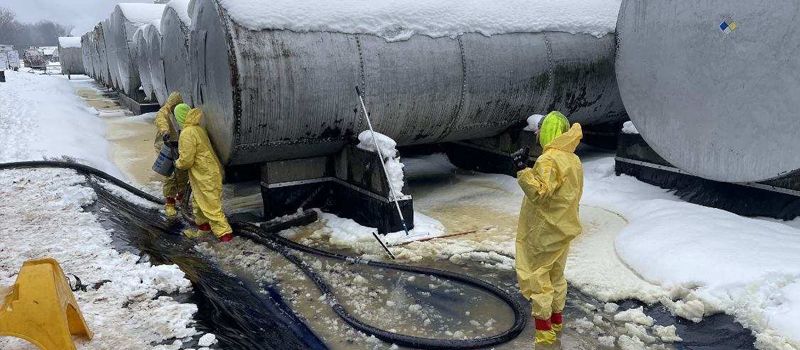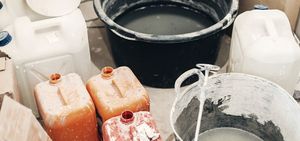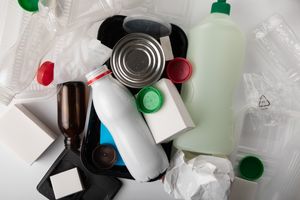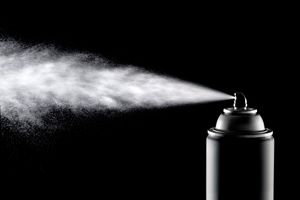Guide to Large-Scale Hazardous Spill Cleanup
This is a info alert
This is a danger alert
This is a success alert
This is a warning alert
This is a dark alert

Introduction
Large-scale hazardous spills pose significant risks to human health, the environment, and local communities. These spills often involve high volumes of dangerous substances, such as industrial chemicals, oil, or hazardous waste, requiring coordinated response efforts from multiple agencies and specialized cleanup teams. This guide outlines the steps for managing large-scale spills in compliance with Western New York regulations and federal guidelines.
1. Common Large-Scale Spill Scenarios
A. Industrial & Manufacturing Spills
Catastrophic pipeline ruptures releasing hazardous chemicals.
Factory explosions or leaks leading to widespread contamination.
Chemical plant disasters requiring mass evacuations.
B. Environmental Disasters & Transportation Incidents
Tanker truck or freight train derailments carrying toxic materials.
Oil spills in water bodies such as the Niagara River or Lake Erie.
Hazardous waste disposal site failures causing widespread contamination.
2. Immediate Response Protocol
A. Public Safety & Evacuation
Evacuate affected areas if the spill poses an immediate health risk.
Activate emergency response teams and local government agencies.
Establish safety perimeters to prevent exposure.
B. Incident Command System (ICS) Activation
Assign a Spill Response Incident Commander.
Coordinate with local emergency management agencies (LEMA).
Mobilize state and federal environmental protection units.
C. Containment & Damage Control
Deploy booms, barriers, and containment systems to limit spread.
Establish decontamination zones for response teams.
Shut down storm drains and water access points to prevent contamination.
3. Reporting & Regulatory Compliance
Large-scale spills require immediate reporting to local, state, and federal authorities.
Location | Reporting Agency | Contact Information |
|---|---|---|
Buffalo, NY | NY State DEC Spill Response | 1-800-457-7362 |
Niagara Falls, NY | Niagara County Emergency Management | 716-438-3171 |
Rochester, NY | Monroe County Department of Environmental Services | 585-753-7600 |
National | EPA Emergency Response | 1-800-424-8802 |
Provide detailed reports including spill type, volume, affected area, and potential hazards.
Maintain compliance documentation for regulatory reviews.
4. Professional Cleanup & Remediation Process
A. Deployment of Specialized Cleanup Teams
Mobilize HAZMAT-certified cleanup crews.
Utilize heavy machinery and advanced decontamination technology.
Implement air, soil, and water quality testing.
B. Containment & Remediation Efforts
Phase 1: Emergency Response & Spill Containment – Immediate action to contain hazardous materials.
Phase 2: Environmental Monitoring & Impact Assessment – Identify affected zones.
Phase 3: Cleanup Operations – Removal of contaminants and restoration of affected areas.
Phase 4: Long-Term Remediation – Ongoing monitoring to prevent long-term environmental damage.
C. Disposal & Environmental Recovery
Transport waste to EPA-approved disposal facilities.
Implement soil and groundwater decontamination procedures.
Conduct post-cleanup environmental impact studies.
5. Preventative Measures & Emergency Preparedness
A. Risk Assessment & Spill Prevention Plans
Industries handling hazardous materials must have Spill Prevention, Control, and Countermeasure (SPCC) Plans.
Regularly inspect pipelines, tanks, and containment areas.
B. Government & Community Preparedness
Conduct multi-agency emergency response drills.
Develop regional response frameworks for large-scale spills.
Strengthen public awareness programs to educate communities on spill risks and safety measures.
Conclusion
Large-scale hazardous spills require immediate action, coordination between multiple agencies, and adherence to strict environmental regulations. By following proper containment, reporting, and cleanup procedures, response teams can mitigate environmental damage and protect public health.
For professional hazardous spill response in Western New York, contact certified HAZMAT specialists and emergency response agencies to ensure proper remediation and compliance.
🔄 Next Steps in Spill Preparedness & Response
Looking to deepen your understanding or take action? Explore these related resources:







